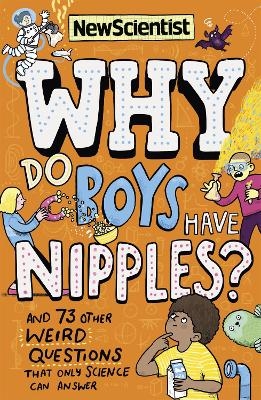
Why Do Boys Have Nipples?
And 73 other weird questions that only science can answer
Seiten
2019
John Murray Publishers Ltd (Verlag)
978-1-5293-1749-7 (ISBN)
John Murray Publishers Ltd (Verlag)
978-1-5293-1749-7 (ISBN)
The Horrible Histories but for science -- packed with all the gross and weird bits.
Why aren't there any green mammals?
Is eating bogeys bad for you?
Do dolphins and whales get thirsty?
Why can't you tickle yourself?
Where do astronauts put their dirty underwear?
Children make excellent scientists - they're inquisitive, keen to learn and have open minds. And they especially love to learn about all the gross stuff and all the weird facts - this book is packed full of them.
In Why Do Boys Have Nipples?, kids will discover how to extract iron from breakfast cereal; that fish communicate by farting; how to turn fried eggs green; why tigers have stripes, not spots; and much, much more.
Behind each surprising question and answer or wacky experiment is a scientific explanation that will teach kids more about biology, chemistry and physics, and the world around them.
Why aren't there any green mammals?
Is eating bogeys bad for you?
Do dolphins and whales get thirsty?
Why can't you tickle yourself?
Where do astronauts put their dirty underwear?
Children make excellent scientists - they're inquisitive, keen to learn and have open minds. And they especially love to learn about all the gross stuff and all the weird facts - this book is packed full of them.
In Why Do Boys Have Nipples?, kids will discover how to extract iron from breakfast cereal; that fish communicate by farting; how to turn fried eggs green; why tigers have stripes, not spots; and much, much more.
Behind each surprising question and answer or wacky experiment is a scientific explanation that will teach kids more about biology, chemistry and physics, and the world around them.
Since the first magazine was published in 1956, New Scientist has established a world-beating reputation for exploring and uncovering the latest developments and discoveries in science and technology, placing them in context and exploring what they mean for the future. Each week through a variety of different channels, including print, online, social media and more, New Scientist reaches over four million highly engaged readers - over a million readers for the print magazine alone.
| Erscheinungsdatum | 09.08.2019 |
|---|---|
| Sprache | englisch |
| Maße | 126 x 196 mm |
| Gewicht | 206 g |
| Themenwelt | Kinder- / Jugendbuch ► Sachbücher ► Naturwissenschaft / Technik |
| Kinder- / Jugendbuch ► Sachbücher ► Religion / Philosophie / Psychologie | |
| ISBN-10 | 1-5293-1749-5 / 1529317495 |
| ISBN-13 | 978-1-5293-1749-7 / 9781529317497 |
| Zustand | Neuware |
| Haben Sie eine Frage zum Produkt? |
Mehr entdecken
aus dem Bereich
aus dem Bereich
Wie groß ist die Unendlichkeit?
Buch | Hardcover (2024)
FISCHER Sauerländer (Verlag)
16,90 €
Das Universum in spektakulären Bildern. Für Kinder ab 8 Jahren
Buch | Hardcover (2022)
DK Verlag Dorling Kindersley
24,95 €


